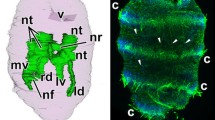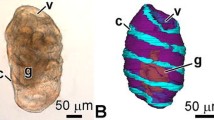Summary
The actinotrocha of Phoronis muelleri has one pair of ectodermally derived, monociliated protonephridia. The duct runs mainly between the epidermis and the lining of the hyposphere coelom, pierces the septum and extends into the blastocoel. The proximal part is branched and closed up by terminal complexes consisting of two morphologically different cells which both serve filtration. During metamorphosis, the terminal complexes and the branches of the duct are cast off. The cells degenerate, pass into the remaining duct and are endocytosed by the duct cells. After metamorphosis the remaining part of the protonephridial duct is U-shaped, blindly closed and borders on the prospective lophophoral vessel. In a later stage the duct receives a ciliated funnel, which consists of monociliated epithelio-muscle cells and is a derivative of the lining of the metacoel. Thus, a part of the protonephridial duct of the larva and the whole metanephridial duct of the adult are identical. Aspects of a possible homology between phoronid nephridia and such organs in other bilaterians are discussed.
Similar content being viewed by others
References
Ax P (1987) The phylogenetic system: the systematization of living organisms on the basis of their phylogenetisis. Wiley Sons, Chichester, New York, Brisbane, Toronto, Singapore. 340 pp
Bartolomaeus Th (1985) Ultrastructure and development of the protonephridia of Lineus viridis (Nemertini). Microfauna Mar 2:61–83
Bartolomaeus Th (1989) Ultrastructure and development of the nephridia in Anaitides mucosa. Zoomorphology 109 (in press)
Bargmann W, van Hehn G (1968) Über das Axialorgan (“mysterious gland”) von Asterias rubens. Z Zellforsch 88:262–277
Brandenburg J (1966) Die Reusenformen der Cyrtocyten. Eine Beschreibung von fünf weiteren Reusengeißelzellen und eine vergleichende Betrachtung. Zool Beitr N F 12/3:345–417
Brooks WK, Cowles RP (1905) Phoronis architecta. Its life history, anatomy and breeding habits. Mem Nat Acad Sci Washington 10:69–111
Caldwell WH (1882) On the structure, development and affinities of Phoronis. Proc R Soc London 34:371–383
Cori CI (1939) Phoronidea. Akademische Verlagsges. Leipzig
Ehlers U (1985) Das phylogenetische System der Plathelminthes. G Fischer Verlag, Stuttgart New York, 317 pp
Ehlers U (1986) Comments on a phylogenetic system of the Platyhelminthes. Hydrobiologia 132:1–12
Ehlers U, Sopott-Ehlers B (1986) Vergleichende Ultrastruktur von Protonephridien: ein Beitrag zur Stammesgeschichte der Plathelminthen. Verh Dtsch Zool Ges 79:168–169
Ehlers U, Sopott-Ehlers B (1987) Zum Protonephridialsystem von Invenusta paracnida (Proseriata, Plathelminthes). Microfauna Mar 3:377–390
Emig CC (1979) British and other phoronids. Synopses of the British fauna (New Series) No. 13. Eds Kermack DM, Barnes RSK, Acad. Press, London, New York, San Francisco. 57 pp
Emig CC (1982) The biology of Phoronida. Adv Mar Biol 19:1–89
Emig CC (1985) Phylogenetic systematics in Phoronida (Lophophorata). Z Zool Syst Evolut Forsch 23:184–193
Goodrich ES (1903) On the body cavities and nephridia of the Actinotrocha larva. Q J Microsc Sci 47:103–119
Goodrich ES (1946) The study of nephridia and genital ducts since 1895. Q J Microsc Sci 86:113–329
Hay-Schmidt A (1987) The ultrastructure of the protonephridium of the actinotroch larva (Phoronida). Acta Zool 68:35–49
Herrmann K (1976) Untersuchungen über Morphologie, Physiologie und Ökologie der Metamorphose von Phoronis mülleri (Phoronida). Zool Jahrb Anat 95:354–376
Holborow PL (1971) The fine structure of the trochophore of Harmothoë imbricata. — In: The fourth european marine biology symposium. Cambridge Univ. Press 1971, p. 237–246
Lammert V (1985) The fine structure of protonephridia in Gnathostomulida and their comparison within Bilateria. Zoomorphology 105:308–316
Masterman AT (1897) On the Diplochorda. Q J Microsc Sci NS 40:281–366
Meisenheimer J (1909) Die Exkretionsorgane der wirbellosen Tiere. Erg Fortschr Zool 2:275–366
Neuhaus B (1987) Ultrastructure of the protonephridium in Dactylopodola baltica and Mesodasys laticaudatus (Macrodasyoidea): Implications for the ground pattern of the Gastrotricha. Microfauna Mar 3:419–438
Peters W (1977) Possible sites of ultrafiltrationin Tubifex tubifex Müller (Annelida, Oligochaeta). Cell Tissue Res 179:367–375
Rice SA (1980) Ultrastructure of the male nephridium and its role in spermatophore formation in spionid polychaetes (Annelida). Zoomorphology 95:181–194
Ruppert EE, Balser EJ (1986) Nephridia in the larvae of hemichordates and echinoderms. Biol Bull 171:188–196
Ruppert EE, Smith PR (1988) The functional organization of filtration nephridia. Biol Rev 63:231–258
Selys-Longchamps M de (1903) Über Phoronis und Actinotrocha bei Helgoland. Wiss Meeresunters (Abt. Helgoland) 6:1–56
Selys-Longchamps M de (1904) Developpement postembryonaire et affinites des Phoronis. Mem Sci Acad Belg 1:1–150
Selys-Longchamps M de (1907) Phoronis. Fauna Flora Golf Neapel 30:1–280
Shearer C (1906) Development of larval nephridia. I. Phoronis. Mitt Zool Sta Neapel 17:154–187
Smith PR, Ruppert EE (1988) Nephridia. In: The ultrastructure of the Polychaeta. Microfauna Mar 4:231–262
Storch V, Herrmann K (1978) Podocytes in the blood vessels of Phoronis mülleri (Phoronida, Tentaculata). Cell Tissue Res 190:553–556
Warner FD (1969) The fine structure of the protonephridia in the rotifer Asplanchna. J Ultrastruct Res 29:499–524
Wilke U (1972) Die Feinstruktur des Glomerulus von Glassobalanus minutus (Kowalewsky (Enteropneusta). Cytobiol 5:439–447
Author information
Authors and Affiliations
Rights and permissions
About this article
Cite this article
Bartolomaeus, T. Ultrastructure and relationship between protonephridia and metanephridia in Phoronis muelleri (Phoronida). Zoomorphology 109, 113–122 (1989). https://doi.org/10.1007/BF00312317
Received:
Issue Date:
DOI: https://doi.org/10.1007/BF00312317




